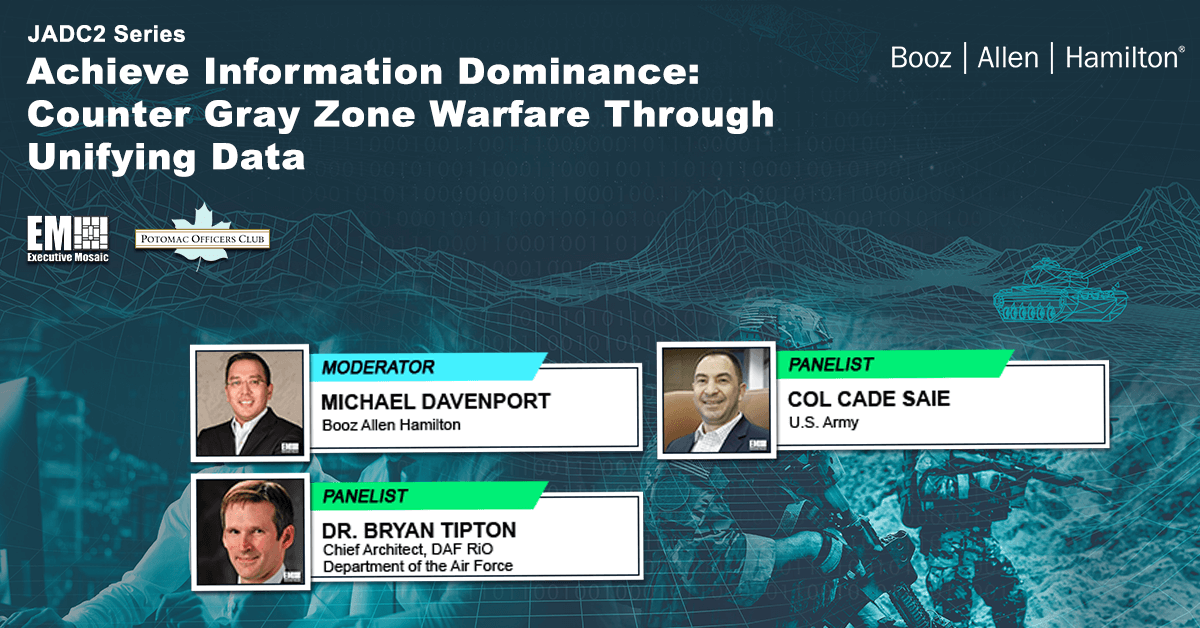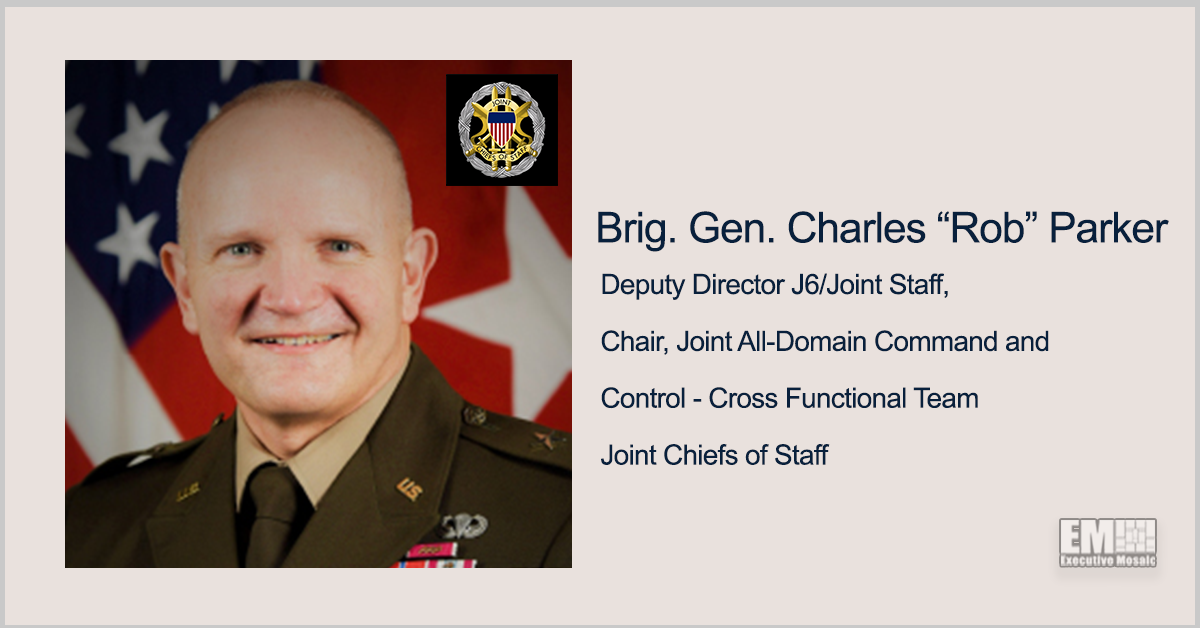Maj. Gen. Peter Gallagher, director of the Network Cross-Functional Team (CFT) with Army Futures Command, and Brig. Gen. Rob Collins, program executive officer for Command, Control, Communications-Tactical (PEO C3T) at the Army, conducted a joint keynote address during Potomac Officers Club’s (POC) Weaponizing Data Across the Digital Battlefield Virtual Event on August 11th.
If you missed the event, check out Potomac Officers Club’s Event Archive to watch Tuesday’s event as well as all recent POC events of 2020.
“In a world where hardware and software technologies continue to evolve…weaponizing data to put in the hands of the warfighter is more important than ever. The advent of innovation such as machine learning, open source technologies and open architecture has enabled us to take this concept to the next level. That is our purpose here today,” said Michael Davenport, senior vice president with Booz Allen Hamilton who also served as the event’s moderator.
Davenport set the stage with a preamble into the evolution of warfare and innovation’s influence on warfighters over recent decades before introducing both MG Gallagher and BG Rob Collins for the joint-opening keynote address discussing the current initiatives within the Army, including data, modernization and the challenges ahead within the modern defense landscape.
To begin the keynote address, MG Gallagher described the current and new initiatives within the Six Modernization Priorities to remain competitive in a multidomain environment. To enact the current mission, the Army developed the Joint All Domain Command & Control (CJDADC2), to focus on four key topics for modernization: sensor integration, effects integration, applications and data.
“Storage, retrieval and access to data underpins all of the nation’s decision making, so as we look to modernize the U.S. Army, we look to enable the CJADC2. The tool to our success is going to be open systems architecture, designed on Application Programming Interfaces (APIs),” said Gallagher.
APIs allow industry to share software and tools and collaborate with federal agencies to create an open architecture. The first initiative in Line of Effort (LOE) 1, which includes communications systems that will provide connectivity across battlefields.
The common operating network serves as the Army’s LOE 2, which will leverage technology and optimize edge computing to enable leaders to make decisions at speed.
LOE 3, or Joint Interoperability & Coalition Accessibility, will provide support to achieve LOE 1 and 2 and ensure that the needs are met.
LOE 4, Mobile & Survivable Command Posts, will ensure that soldiers will be able to retreat from the fixed site command post. It will create platforms that are equipped with systems to move quickly and stay connected.
Gallagher moved onto the Army’s four lines of effort under the Targeted CS23 Capabilities, including unified network, common operating environment, joint interoperability/coalition accessible and command post (CP) mobility/survivability.
The U.S. Army’s unified network will develop a modular, open suite of standards and high capacity communications to provide a multi-use chassis that supports maximum flexibility moving forward in the battlefield.
In the common operating environment, the Army put a ton of emphasis into our cloud capabilities to develop a distributed data computing architecture to accelerate the speed and deployment of new capabilities for the service branch.
Joint Interoperability/Coalition Accessible and Command Post (CP) Mobility/Survivability will provide multi-level security (MLS) and enhanced command post designs, respectively.
“To amplify and strengthen our relationships with the network CFT, one of the things we recently completed was to set up a PM interoperability as well as integration services to align the four lines of efforts and optimize our capabilities set. That will set up an enduring process we will deliver,” said BG Collins.
BG Collins and MG Gallagher also addressed the Army’s Common Operating Environment (COE), which will produce technologies and standards to a common foundation to allow the Army to deliver warfighting capabilities as software applications.
COE will provide soldiers with a range of tools to improve access to information, while reducing soldiers’ training and logistics. The environment will make the Army more efficient, more operationally effective and more cyber secure.
In order to enhance the COE, the Army is investing into its infrastructure, which includes common software and high performing servers that can do the work previously performed by multiple stovepiped machines.
Stovepiped mission command systems will also be replaced by integrated web applications to enhance staff collaboration and increase operational agility. The systems will share the same map engine, chat function, and secure underlying data, to enhance staff collaboration and increase operational agility.
The COE will streamline interactions with coalition partners and improve the Army’s ability to efficiently label data and share information, which will preserve cybersecurity while reducing manual obstacles to collaboration with other nations and agencies.
The Army’s COE will also enable the service branch to better prevent, respond to and recover from cyber attacks. COE will reduce the number of network access points to lower vulnerability, seal the seams between systems and improve visibility across the enterprise and tactical networks for a common operating picture that can detect intrusion.
“MG Gallagher is focused on the ‘what,’ and on our side, we are focused on the ‘how.’ We’re going to have to focus on our competitive advantage, mission command and decentralized execution. Our goal within COE is to create an industry-like model to operate at the speed of threat. It will allow us to increase our agility,” said BG Collins.
To hear more from Collins and Gallagher, click here to view the event in Potomac Officers Club’s Event Archive.
Potomac Officers Club’s 5th Annual Army Forum is coming on August 27th. Bruce Jette, assistant secretary of the Army for Acquisition, Logistics, and Technology (ASA(ALT)) and 2020 Wash100 Award recipient, will serve as the keynote speaker at the forum.
During the 5th Annual Army Forum, Jette and other influential executives from across the service branch will discuss the progress, innovations and accomplishments of the Army’s modernization renaissance over the last year, what challenges remain, and how industry can help in 2021 and beyond.
Register here to join Potomac Officers Club for the 5th Annual Army Forum on Thursday, Aug. 27th to learn more.






